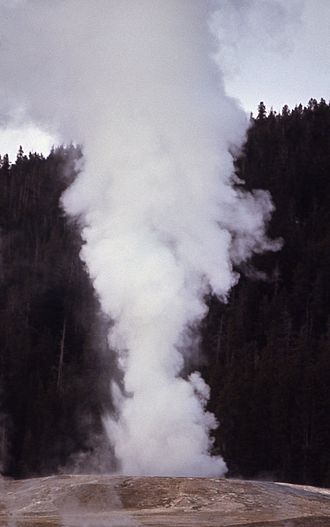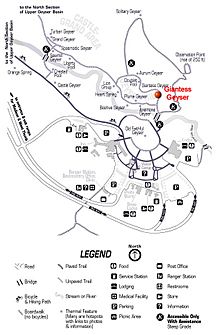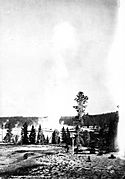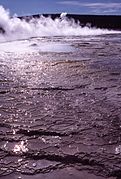Giantess Geyser facts for kids
Quick facts for kids Giantess Geyser |
|
|---|---|

Giantess Geyser
|
|
| Location | Upper Geyser Basin, Yellowstone National Park, Teton County, Wyoming |
| Coordinates | 44°27′49″N 110°49′44″W / 44.4635358°N 110.828924°W |
| Elevation | 7,428 feet (2,264 m) |
| Type | Fountain |
| Eruption height | 100 to 200 feet (30 to 61 m) |
| Frequency | Infrequent |
| Temperature | 90.4 °C (194.7 °F) |

Upper Geyser Basin
|
|
The Giantess Geyser is a super cool geyser found in the Upper Geyser Basin of Yellowstone National Park. It's called a fountain-type geyser because it shoots out many bursts of water, not just one big stream.
This geyser is famous for its powerful, but rare, eruptions. When it erupts, water bursts can shoot up from 100 to 200 feet (30 to 61 m) into the air! Imagine a building 10 to 20 stories tall!
Giantess Geyser doesn't erupt very often, usually only 2 to 6 times a year. Sometimes, the ground around it might even shake a little before an eruption. This happens because of steam explosions underground. Once it starts, an eruption can last a long time, from 4 to 48 hours! It might even erupt twice in an hour during this time.
The last time Giantess Geyser erupted was on August 26, 2020. Before that, it hadn't erupted for over six years! But then, just 15 days later, on September 10, 2020, it erupted again.
Discovering the Giantess Geyser
The Giantess Geyser was one of the first geysers to be officially named in Yellowstone National Park. This happened during an important trip called the Washburn–Langford–Doane Expedition in 1870. Seven geysers got their names during this expedition.
Early Explorers' Amazing Descriptions
Walter Trumbull, who was part of the expedition, wrote about the Giantess Geyser in his diary on September 18, 1870. He thought it was one of the most amazing geysers they saw.
Trumbull described the ground around the geyser as gently rising to its opening. He noted that unlike other geysers, there wasn't a big mound around its crater. When it was quiet, he saw a clear, beautiful pool of water. He said it looked like a "subsilica urn, or vase" with a hollow stem. Steam would bubble up from this stem, like champagne fizzing in a glass.
The opening of the geyser was about 20 by 30 feet wide. Fifty feet below, the "neck" of the geyser was 15 by 10 feet. Sometimes the water would drop to the level of this neck, and other times it would rise almost to the surface.
When the Giantess Geyser erupted, Trumbull saw it become a "fountain with five jets." These jets of water shot up to 200 feet high! The biggest jet was about two feet wide at the surface. It stayed as a solid column for over 150 feet before breaking into drops and spray.
Trumbull saw one eruption just before sunset. The last rays of light made the glistening water drops look like a rainbow. The clouds of steam also looked like "golden fleece" with rainbows around them. He felt that even though it wasn't as big as "The Giant" geyser, the Giantess was "by far the most beautiful sight" they saw in the geyser basin.
Nathaniel P. Langford also wrote about the Giantess Geyser in his diary from the 1870 expedition. He described it as the largest geyser they saw erupt.
Langford wrote about walking up a gentle slope to reach the geyser's opening. It was an irregular oval shape, about 15 by 20 feet across. They could see down about 50 feet but couldn't see water, though they could hear it gurgling and boiling deep inside.
Suddenly, the water started bubbling and rising very quickly. This made everyone in their group move to the side away from the wind! When the water was about 25 feet from the top, it stopped rising. They looked down at the foaming water, which occasionally shot hot jets almost to the opening.
Then, the water began to rise quickly again, about five feet per second! When it reached the top, it was pushed out with incredible force. A column of water, the full size of the opening, shot up 60 feet high. This main column stayed at that height for about a minute.
From the top of this huge water column, five smaller jets shot even higher, reaching an amazing 250 feet into the sky! Langford called this the "most magnificent phenomenon" he had ever seen. The sun's rays made the water column sparkle like "clippings of a thousand rainbows." These sparkling effects continued throughout the 20-minute eruption.
Langford thought these higher, smaller jets might come from other pipes connected to the main opening deep down, where the explosive force is stronger. He said the tiny drops of water falling back down sparkled like "a shower of diamonds." He and his group all agreed that the Giantess Geyser was the greatest wonder of their trip.
See More Pictures
- Images of Giantess Geyser
-
Thomas Moran's illustration from The Wonders of the Yellowstone, 1871
-
Giantess Geyser Crater, 1872 William Henry Jackson






